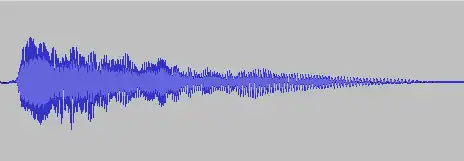Digital vs Analog
The previous chapter explained the difference between physical sound and computerized sound while this chapter will cover a more audio engineering scope. The difference between digital recordings and analog recordings. In our modern world, fully analog workflows are hard to come by and are largely an unessessary expense for similar results in-the-box.
Digital Recordings
In the digital realm, audio is encoded as 1s and 0s. The most typical way to display and encode sound is by using a waveform, which consists of a continuous sinusoidal line that changes over time. (Although this is not exactly correct in the digital realm and will be explored in depth later.) In a standard view of a waveform, the X-axis represents time, while the Y-axis denotes the volume, also known as the amplitude of the signal.

In the picture above, it's very clear how the sound develops over the time axis. Different instruments have different volume shapes, more commonly called the "Envelope" of the sound. Envelopes are very important when it comes to sound design using synthesizers but can be useful in other areas of audio engineering. Being able to visually tell what is happening with your sounds is a good skill to have. However, using your ears is the most important skill.
A few other features of digital recording include bit-depth and sampling rates, however these will be discussed in more detail in later chapters since they are not crucial for a beginners to understand. In this regard, the default settings of a DAW is all that you need when starting out.
Analog Recordings
As mentioned previously, a completely analog recording workflow is extremely uncommon in our age of technology. Tape is expensive and hard to work with, mixing desks require constant maintenance, and dealing with patch bays or piles of cables can be a nightmare. But producers and musicians still strive for that analog sound. Why is that? Well, it's not all nostalgia; there are some benefits to analog that are simply not possible in the digital realm.
One of the obvious features of analog is the unpredictability and randomness of equipment. Real hardware creates noise, buzz, hisses, and can react slightly differently to sound every time you play something through it. This is something that is impossible to replicate in-the-box even with the best emulations because computers are inherently logical and accurate. Randomness does not exist in a computer, so you cannot create true organic effects digitally. Although you can come very close to the real thing, some people still pine over decades-old gear for its unique real sound.
An additional benefit of analog technology lies in its inherent resistance to clipping. In the analog domain, as the volume increases and audio is channeled through analog equipment, it becomes more saturated and distorted. This stands in stark contrast to the digital domain, where the phenomenon of digital clipping occurs, resulting in the loss of data for any peaks exceeding 0dB. While certain musical genres may intentionally embrace this digital clipping effect, it is generally perceived as unpleasant and functions quite differently from analog gear.
Unlike digital counterparts, analog gear is incapable of clipping, providing a smoother and more manageable experience in the mixing process. This attribute contributes significantly to the distinctive warm and crunchy sounds found in many classic tracks, underscoring the enduring appeal of analog equipment in the realm of audio production.